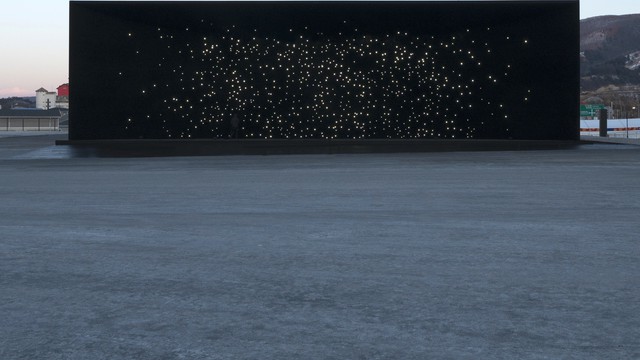Hyundai Pavilion Field of Stars 2018, South Korea, Pyeongchang
A glittering field of stars in front of the darkest building on earth




Hyundai Motor commissioned a pavilion for the Pyeongchang Winter Olympics 2018 in South Korea. The facades were entirely coated in a super-black material that is able to absorb 99% of the light that hits its surface. They were illuminated by a field of stars that appeared to float in mid-air, simulating the view into space from that point on earth. The brightness of the lights was continually adjusted to the ambient light and an interference effect created the illusion of twinkling stars in the night sky. As part of a series of projects that highlight Hyundai’s new Hydrogen Fuel Cell vehicle, the facades of the pavilion represented the Universe – the origin of Hydrogen.
Hyundai Motor commissioned a pavilion for the Pyeongchang Winter Olympics 2018 in South Korea. The building’s facades were entirely coated in a super-black material and were illuminated by a field of stars that appeared to float in mid-air. The pavilion’s 10-metre-high parabolic facades were finished with Vantablack VBx2, a derivative of the original Vantablack, making it the world’s largest continuous nanostructure. The matt black material is able to absorb 99% of the light that hits its surface, diminishing its three dimensionality and creating the illusion of a startling black void in broad daylight. The facades of the pavilion were punctuated by thousands of tiny white lights which, during the day, simulated the view into space from that point on earth. An interference effect was used to create the illusion of twinkling stars in the night sky. It caused the light points to shimmer in a way that came close to the refraction of light in the Earth’s atmosphere. To further enhance a feeling of depth, the lights were fitted on rods of different lengths, thus creating a parallax as visitors moved in front of the building. The brightness of the LEDs was primarily determined by two factors. First, it depended on the visibility of the actual star and on the distance of the LED from the viewer. Second, it was adjusted according to the ambient light measured by a sensor and controlled with a precision of 16 bit. The exact adaptation to the ambient light led to continual changes in the pavilion's appearance. The pavilion was part of a series of projects that highlight Hyundai’s mission to enhance people’s lives through ease of mobility. With its pioneering technology for the world’s first Hydrogen Fuel Cell vehicle produced in series, Hyundai envisions a future society where mobility is both sustainable and accessible. The black facade of the pavilion represented the Universe – the origin of Hydrogen.
Details
Building or project owner : Hyundai Motor Company
Architecture : Asif Khan
Project artist/ concept/ design/ planning : Asif Khan, iart
Structural engineering : AKTII
Facade design : Asif Khan
Facade construction : GL
Light design : Asif Khan
Technical layout light : iart
Display content/ visuals/ showreel : Asif Khan, iart
Light hardware (LED hardware) : iart
Lighting control software : iart
Project co-ordination : Innocean Worldwide
Interaction design/ programming : Asif Khan, iart
Descriptions
Facade type and geometry (structure) : The pavilion measured 35m (width) x 35m (width) x 10m (height). Its facades were designed parabolic shape to let as little daylight as possible hit the surface.
Kind of light creation : We used high-power LED Whites with a colour temperature of 4000K and 1W per LED. They were cast in a custom, waterproof housing and placed on aluminium rods.
Resolution and transmitting behaviour : Approximately 2000 LEDs were used in total, each with 16 bit resolution.
Pixel distance : The arrangement of the LEDs was based on stellar constellations. In order to suggest a feeling of depth (parallax), the LEDs were fitted on rods of different lengths (30 cm – 3m).
Urban situation : The pavilion was located at a central site in the Olympic Park in Pyeongchang and attracted a total of 60,000 visitors.
Description of showreel : To create the illusion of twinkling stars, an interference effect was used. It caused the light points to shimmer in a way that came close to the refraction of light in the Earth’s atmosphere. The brightness of the LEDs was determined by the visibility of the actual star and the distance of the LED from the viewer, and adjusted according to the ambient light measured by sensors (one per facade).
Participatory architecture & urban interaction
Mediacredits
Luke Hayes
iart
iart
iart
iart